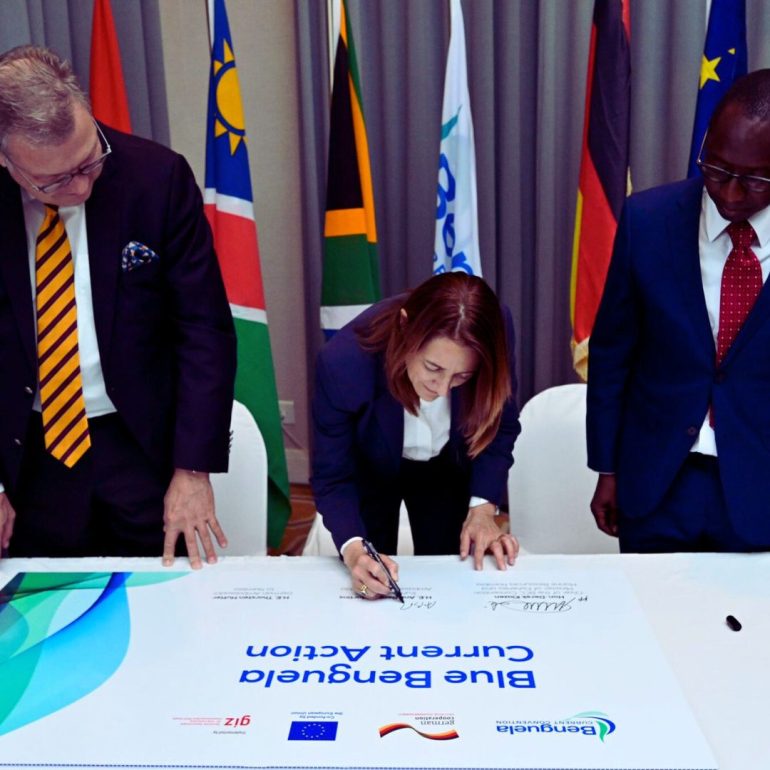Omanyano ovanhu koikundaneki yomalungula kashili paveta, Commisiner Sakaria takunghilile
Veronika Haulenga
Omanyano ovanhu koikundaneki yomalungula kashili paveta, Commisiner Sakaria takunghilile
Veronika Haulenga
Listeners:
Top listeners:
-
play_arrow
Omanyano ovanhu koikundaneki yomalungula kashili paveta, Commisiner Sakaria takunghilile Veronika Haulenga
In Brazil’s soy belt, community seed banks offer hope for the Amazon


By Ana Ionova
Not too long ago, the plot of land that Maria Ivonete de Souza inherited was barren, the soil hardened by years of cattle ranching. When the family had arrived to the Amazon from southern Brazil four decades earlier, her father had swiftly cleared the dense rainforest to make way for pasture.
“He razed it all by hand, with a saw and an ax,” Souza said on the porch of her wooden farmhouse on the dusty outskirts of Colíder, some 393 miles (632 kilometers) north of Mato Grosso’s state capital. “It’s horrible to be talking about this. Because I’m recalling things that bother me deeply today.”

Now, decades later, Souza is fighting to turn back the clock on destruction in this region. In a bid to reforest, she has planted seeds from species that are native to the rainforest but have begun to vanish from here, as soy and corn production expand at a frenzied pace.
“If people knew how difficult it is to plant trees, they would never even dream of cutting them down,” said Souza, who leads the community organization Coletivo Agúa Vida. “Here, we want to do things differently. We want to restore the forest to health.”
A key part of this dream is building a community seed bank that can help rehabilitate the native vegetation and protect the biodiversity being wiped out by monoculture in Mato Grosso, Brazil’s biggest producer of grains. Souza has helped organize events bringing together the region’s subsistence farmers, Indigenous people and traditional communities, so they can swap seeds and know-how.
“It’s so important for us to have these seeds,” she said, waving to a cluster of mismatched canisters holding seeds in shades of brown, yellow and red. “And we have to share, so that this seed doesn’t disappear.”
Local seed initiatives like these are gaining momentum across Brazil – and they are emerging as a key tool for reforestation, as the country looks to make good on its pledge to rehabilitate 60,000 square kilometers (23,160 square miles) of deforested and degraded land by 2030. Proponents say planting seeds – rather than seedlings – can be a cheaper, faster and more efficient way to restore decimated forests, helping Brazil meet its ambitious target.

Scientists also claim forest restoration through seeds can help recuperate some of the biodiversity that is being lost through deforestation. Unlike government seed banks, which store samples for historic preservation, community banks collect seeds, exchange varieties and ultimately plant a medley of them, in a bid to mimic the forest as closely as possible.
If applied on a large scale, reforestation through native seeds could play a crucial role in offsetting some of the destruction that has swept the Amazon in recent years, while also staving off a climate crisis that is already hitting local communities, according to Luciana Gatti, a senior researcher in climate change for the Brazilian National Institute for Space Research (INPE).
“The key is to plant trees, trees and more trees,” she said. “Reforestation is our only way out of this.”
‘The forest is like a rain factory’
In Mato Grosso, the trappings of agriculture are everywhere. On street corners, towering billboards offer new brands of seeds, pesticides and tractors. Politicians campaign on promises for bold infrastructure projects aimed at boosting soy and corn output. Towns that were specks on the map a few decades ago are booming, fueled by the world’s insatiable hunger for commodities.
Satellite imagery visualized by Google Timelapse shows forest loss in Mato Grosso between 1983 and 2022.
Since the early 1980s, the area occupied by agriculture and cattle in Brazil has jumped by 50%, according to a recent study by MapBiomas, a Brazilian environmental think tank. But scientists say this dizzying growth has come at a steep cost for the climate: repeated heat waves, erratic rain patterns and punishing droughts have become commonplace in the Amazon in recent years.
“The forest is like a rain factory,” Gatti said. “It churns out water and it also cools temperatures. So it plays a big role in climate.”
The impacts of climate change on the Amazon reached new proportions this year, as historic drought dried up important rivers, decimated subsistence crops, curbed hydropower supplies and isolated remote riverside communities, leaving many without food and medicine. On a recent visit to the region, the devastation was evident as our car slid past streams that had run dry and fields parched from weeks without rain.
Large-scale agriculture, which consumes 70% of Brazil’s freshwater supplies, is the main culprit of this deepening climate crisis, according to Gatti. “The problem is this model of planting a sea of soybeans,” she said. “Monoculture is destroying the climate.”
The impact of monoculture is two-fold, she explained. On one hand, fewer trees mean the forest is able to recycle less water back into the atmosphere, resulting in reduced rainfall. The forest then grows drier, which diminishes its ability to regulate temperatures. (Researchers have linked temperature anomalies in the Brazilian Amazon and Cerrado to deforestation events up to 50 km away).

The ideal would be to reforest en masse and move towards an agroforestry model, where native species grow alongside other crops. “That way, you have agricultural production and, at the same time, you preserve trees that will help make rain and reduce temperatures,” Gatti said.
The climate impacts of deforestation go far beyond Brazil too. Vapor from the Amazon rainforest canopy accounts for about a fifth of the oxygen released into the atmosphere each day. The rainforest is also both the world’s biggest carbon sink and a huge source of potential emissions, holding an estimated 123 billion tons of carbon. When trees are cut down, the destruction deals a major blow to the global climate because more carbon dioxide is released and less is absorbed.
As a result, scientists insist that restoring native forests, in Brazil and elsewhere, represents one of the planet’s best hopes for mitigating climate change, both locally and globally. And in the long-term, research suggests these restored forests in the Amazon can help regulate rainfall and prevent important rivers from drying out.
“The species that have the power to restore balance are the species native to that environment,” Gatti said. “And the more they grow, the more water they will throw into the atmosphere.”
‘The more, the better’
Scientists also warn that species native to the Brazilian rainforest are disappearing – and many point a finger to monoculture.
Although the full scope of the Amazon’s biodiversity is unknown, some studies estimate that it may hold between 15,000 and 50,000 species of flora. And research has suggested that climate change and forest destruction could lead to a 58% decline in tree diversity in the Amazon by 2050.
Community seed projects are working to combat this diversity loss by using a method called “muvuca,” which relies on spreading a large and varied mixture of mostly native seeds across degraded areas, to assure a higher diversity of plants and trees.
“We try to truly imitate the forest as it is, sowing all the seeds at the same time,” said Renato Nazário, a forest restoration technician at the Xingu Seed Network, a nonprofit providing support and training to about two dozen community seed initiatives in the Amazon. “And each one has a different role in the reforestation process.”
Typically, about a third of the seeds are rapidly-growing non-native species, such as squash and jack beans, that act as “green fertilizers.” This vegetation provides food and income for local communities, as well as safeguards against invasive plants, so that other native tree species like copaiba (genus Copaifera), cashew (Anacardium occidentale) and pequi (Caryocar brasiliense) can have a chance to mature. Some trees reach maturity in 20 years, while others take as long as 50 to grow to their full size.
“The more species the better,” said Nazário, noting this method can yield between 5,000 and 12,000 species per hectare. “This shows it’s possible, through ecological restoration, to recuperate the forest’s biodiversity.”

For some communities, the very process of collecting seeds has become a livelihood, explained Nazário, whose organization works with about 600 seed collectors, mostly women from Indigenous and traditional communities. Many manage to earn a living selling samples of native species to companies seeking to reforest degraded land and offset their environmental footprint.
“It generates an income for these collectors, without forcing them to leave their territories,” he said. “And they can put their ancestral knowledge of the forest to work.”
Seed initiatives also represent a powerful tool for preserving Indigenous culture, which relies on traditional plant species that are disappearing as soy plantations replace forests, according to Edilza Karo, an agronomist and researcher from the Munduruku Indigenous people.
“Today, agribusiness is growing so strong,” she told Mongabay in an interview in Mato Grosso. “And it’s affecting our territories, it’s destroying our forest. Our plants, our foods are no longer the same.”
Over the last few decades, species that were once important medicines or staples in Indigenous diets, like certain types of maize, have vanished in some villages deep in the rainforest. Some trees which yielded seeds and fibers for traditional jewelry, headpieces or artisan wares have also become scarce, dealing a blow to cultural traditions.
“There, in our forest, we have our food, our medicine, our housing – that’s why the land is so important to us,” said Karo, who began studying agronomy in a bid to strengthen Indigenous agriculture and culture. “But so many traditional species have been lost or forgotten.”

Seed banks have offered a new way to combat these losses: at seed exchange events, Indigenous leaders sometimes discover plant varieties that have become extinct in some territories but continue to thrive in other corners of the rainforest. “Slowly, we are strengthening our culture,” she said. “And it’s giving us some hope that we can save our forest.”
New way forward
Restoring forests through seeds could be a game-changer for agribusiness too, as the sector faces mounting pressure – at home and abroad – to reverse some of the damage it has inflicted on the Amazon rainforest.
International commodities buyers, including giants like Cargill, have pledged to clean up their supply chains of deforestation, promising to stop buying from producers who raze forest and degrade land. Brands in Europe and the United States, meanwhile, have threatened to boycott Brazilian companies if they don’t stop destroying the rainforest.
Experts say seed banks could provide companies with a more practical, cost-effective way to restore degraded land. For one, the seeds are easier to transport from remote forest communities, along rough roads and treacherous riverways, to far-away buyers. They can also be planted using the same machinery that large-scale farmers already use to sow corn or soy, said Eduardo Malta, a restoration expert at the Instituto Socioambiental (ISA) and a coordinator of Redário, which links collectors with buyers and aids in the logistics and distribution of seeds.
“It’s still very hard to mechanize the planting of seedlings,” he said. “With seeds, we can use the same technology that agriculture already uses – and scale up the restoration.”
Planting seeds directly into the soil also leads to stronger, more grounded roots which help trees weather drought and extreme weather events, Malta added. And the high density of “muvuca” planting means that invasive species are less likely to proliferate and jeopardize reforestation efforts. “It’s not only more practical, but we also see better results,” Malta said.
Yet this method of restoring forests is not completely fool-proof. Building up a steady supply stream of native seeds remains difficult, with collectors often facing logistical challenges that limit the quantity of seeds they can store or ship. In lieu of any federal program to support seed collection efforts, communities depend on networks like Redário to connect them with buyers.
Creating a marketplace for native seed species has also posed a challenge, as many farmers see restored forests as a waste of resources, Nazário said. And, for now, most of the demand for seeds comes from large firms in the mining, agriculture and infrastructure sectors that have been forced, often by a judicial order, to offset their environmental impact by restoring degraded land.
“The producers see planting trees, ecological restoration, as a loss of productive land,” Nazario said. “So oftentimes, they only recuperate these areas when it becomes a legal obligation or a requirement to access the export market.”

Still, there are signs that could soon change. Last year, President Luiz Inácio Lula da Silva signaled plans to offer incentives, including cheap financing, to large-scale agricultural producers who buy up degraded pastures and restore them.
In December, Brazilian lawmakers also approved the creation of a carbon credit market, although the measure was criticized for leaving out agriculture and cattle ranching from the new regulatory requirements.
These two measures could help lure agribusiness to reforestation and boost demand for native seeds, according to Nazário. “Some producers are waking up and seeing an opportunity in this new carbon market. So, this could spark more restoration.”
Long-awaited changes in Brazil’s rural land registration system are also awakening interest in reforestation through native species, according to Manuel Vieira, a forest engineering professor at the Federal University of Amazonas. “If restoration wasn’t a buzz word in the Amazon before, it certainly is becoming one,” Vieira said.
Currently, many agricultural producers are hesitant to invest in reforesting without a land title in hand. But, if the reforms move forward, landholders will have an assurance that their properties will not be taken away. “It could give them that push to invest in reforestation,” said Vieira, who coordinates the university’s Center for Native Seeds of Amazonas.
For Souza, the impacts of forest restoration have become clear. Already, her 60-hectare lot has turned lush, resembling an emerald oasis in the midst of the parched soy fields that stretch for miles all around. Many of the species that now grow on her farm sustain her family. “The land yields way more food than we can eat,” she said, waving to the banana palms and cassava bushes nearby.
She hopes that she can turn the area around her farm into an ecological hub, where seeds, plants and crops will be freely exchanged in the community. She’s swimming against the current, she says, but she’s hopeful the forest can thrive again. “We are looking to the future,” she said. “We want to create something that will last forever.”
Banner image of a cashew “apple” by S.Ballal via Wikimedia Commons (CC BY-SA 3.0).
Written by: Contributed
agribusiness Agriculture Amazon biodiversity Brazil Carbon Credits carbon sink Climate Change Climate Crisis Deforestation Environmental Impact Indigenous communities land management Land Reform land use monoculture native seeds reforestation restoration seed banks Sustainable Agriculture
Similar posts
Windhoek Weather
Most popular

Namdia Heist: More questions, lots of confusion

Omuhwahwameki Michael okuunganeka oshikonga shoku patitha oostola dho Rani moshilongo ashihe.

Walvis Bay woman loses over N$777.000 to a fraudster

Don’t let Pohamba’s tears over Nujoma’s death go to waste

Justice Served: Jandre Dippenaar Found Guilty of Six Murders in Swakopmund Court
Copyright 2025 Future Media (Pty) Ltd | Website by Digital Platforms
Tel: +264 83 000 1000 | Email: news@futuremedia.com.na





